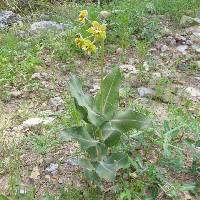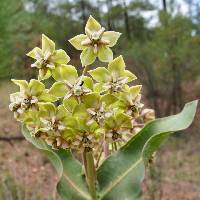- Home
- Search
- Images
- Datasets
- Sample Use
- How to Cite
- Additional Information
- About NEON
- NEON Data Portal
- ASU Biocollections
- About Symbiota
|
|
|
|
Family: Apocynaceae
|
Sundell 1993, Woodson 1954, Kearney and Peebles 1969 Duration: Perennial Nativity: Native Lifeform: Forb/Herb General: Herbaceous perennials, 40-80 cm tall; stems erect and stout, unbranched; herbage glabrous to glaucous; plants with milky sap. Leaves: Opposite and sessile or short-petiolate, the petioles 2 mm long; leafy bracts subtending the peduncles are alternate; blades broadly oblong to ovate-elliptic, 3-16 cm long, 1-7 cm wide, tips rounded or ending in a narrow point, bases shallowly cordate and more or less clasping, surfaces glabrous on both sides or glaucous beneath. Flowers: Large, showy, and greenish, in 1-several large umbels 5-7 cm broad, on peduncles 3-15 cm long in the uppermost nodes; corollas green or with a touch of purple on the tips outside, tardily reflexed-spreading, the lobes 9-12 mm long; hoods yellowish with white margins, sessile and attached along almost the entire height of the column, ovoid-oblong and more or less -J--shaped, horizontally spreading-saccate from the base, curved upward near the middle to an erect, truncate apex, 4-5 mm long and 2-4 mm broad at the top, slightly shorter than the gynostegium; horns radially flat, attached the full length of the hoods, triangular to sickle-shaped, mostly concealed within the hoods; calyx lobes 5-8 mm long; surfaces finely pubescent . Fruits: Follicles erect on deflexed pedicels, 11-15 cm long. Ecology: Found in mountains, canyons, rocky stream beds, openings in pine forests, and open oak-pine woodlands, from 4,000-7,000 ft (1219-2134 m); flowering July-September. Distribution: Ranges from Arizona across southern New Mexico into southwest Texas and south through Mexico and Guatemala to El Salvador and Costa Rica. There is an intermixing with the similar A. glaucescens in central Mexico. Notes: Distinguished by the glaucous herbage (covered with a whitish or bluish waxy coating); the greenish-white corolla lobes; the horns being inside the hoods; and the broad leaves and pendulous umbels. Look for it mostly in the mountains of southeastern Arizona. Known to occur in Cochise, Gila, Pima, Graham, and Santa Cruz counties in Arizona. There has been some taxonomic uncertainty in the past because of misnaming this species A. glaucescens, a species that is known from further south in Mexico toward Oaxaca. Ethnobotany: Unknown, but other species in the genus have uses. Etymology: Asclepias is named for the Greek God of healing Asklepios; elata means -high- or -elevated,- presumably referring to the plant-s height. Synonyms: Asclepias glaucescens var. elata, Asclepias macroura Editor: LCrumbacher 2012, SBuckley 2014, AHazelton 2015 |




